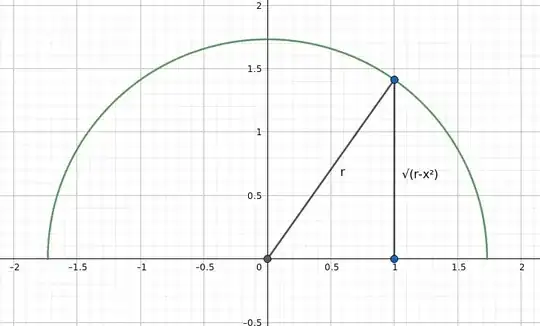Here is a rigorous proof.
First, we need a definition for the distance of two points along a section of a curve. This is called arc length and is defined as the limit of the sum of line-segments of the curve.

The proper definition may be found here. Using this definition, it follows that the arc length $s$ between two points $a$ and $b$ for a continuously differentiable function $f: \mathbb{R} \to \mathbb{R}$ may be calculated by
$$ s = \int_a^b \sqrt{1 + f'(x)^2} dx$$
Lets compute with this formula the arc length $s$ of the upper half of a circle with radius $r$. Using Pythagoras the function describing the upper circle goes from $-r$ to $r$ and is defined as $f(x) = \sqrt{r^2-x^2}$

Also by the chain-rule we have
$$ f'(x)= \frac{-x}{\sqrt{r^2-x^2}}$$
thus
$$ s = \int_{-r}^r \sqrt{1 + \frac{x^2}{r^2-x^2} } dx = \int_{-r}^r \sqrt{ \frac{r^2}{r^2-x^2} } dx= \int_{-r}^r \sqrt{ \frac{1}{1-(x/r)^2} } dx$$
which is if you substitute* with $\phi(x)=rx$:
$$ s =r \int_{-1}^1 \frac{1}{\sqrt{1-x^2}}dx $$
Now
$$\int_{-1}^1 \frac{1}{\sqrt{1-(x)^2}} dx:= c_0$$
is clearly a constant that does not depend on the circle (it does not depend on $r$). Since $2s=C$ is the circumference and $2r =d$ is the diameter we have
$$\frac{C}{d} = \frac{s}{r} = c_0$$
for any circle. Which shows, that the ratio between the circumference and diameter of any circle is always $c_0$. This constant is known by the symbol $\pi$.
*To be precise, the substitution rule is
$$ \int_{a}^b h(\phi(x)) \phi'(x) dx = \int_{\phi(a)}^{\phi(b)} h(u)du $$
in this case we have $$ h(x) = \sqrt{\frac{1}{1-(\frac{x}{r})^2} } \text{ and }\phi(x) = rx$$


